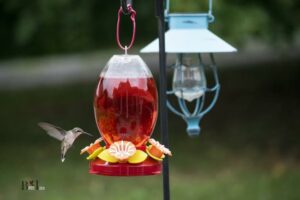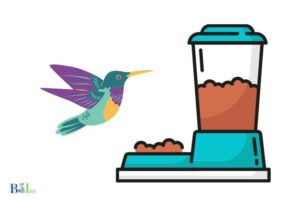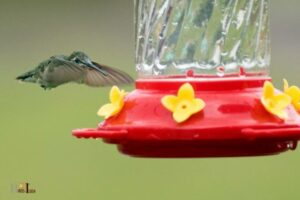Can You Hold a Hummingbird: No, Explore!
No, it is not safe to hold a hummingbird.
Hummingbirds are tiny creatures with extremely fast metabolic rates. They are susceptible to stress and can be easily harmed.
Holding a hummingbird can cause them undue stress and could potentially hurt them due to their delicate nature.
Therefore, unless you are a trained professional, it is recommended to appreciate their beauty from afar.
Additionally, they are wild animals, and they should not be tamed or habituated to humans.
Hummingbirds may look delicate and fragile, but they have powerful muscles that can help them zip around quickly.
Humans should not attempt to handle hummingbirds without the appropriate protective gear and experience in doing so, as it can harm the bird and put it at risk of injury or even death.
7 Possibilities of Hold A Hummingbird
| S.No | Possibility | Description |
|---|---|---|
| 1 | Capturing a Hummingbird | It’s generally not advised to hold a hummingbird due to their delicate nature, but professionals handling them for research, rescue or rehabilitation purposes may do so. |
| 2 | Holding a Hummingbird While Feeding | A hummingbird feeder may encourage the bird to land on your hand while feeding. This is more of a calm, relaxed interaction rather than physically holding the bird. |
| 3 | Rescuing a Hummingbird | If you find an injured or exhausted hummingbird, holding it carefully for its safety or to transfer it to a professional caretaker may be possible. |
| 4 | Domesticated Hummingbird | It’s not common or recommended, but theoretically a domesticated hummingbird might be more open to human interaction. |
| 5 | Handling a Baby Hummingbird | If you find an orphaned baby hummingbird, you might be faced with the sensitive task of holding it. This should only be done under the guidance of an expert. |
| 6 | Helping the Hummingbird out of Predicament | If a hummingbird is stuck somewhere or entangled in something, it might be necessary to hold it temporarily for assistance. |
| 7 | Holding a Hummingbird in a Zoo or Aviary | Some zoos or aviaries allow visitors to have close encounters with birds, though this is not common with hummingbirds. |
Key Takeaway

Five Facts About: Holding a Hummingbird
DID YOU KNOW
There are over 330 species of hummingbirds in the world, with around 19 different species found in North America.
Why Is It Not Safe to Hold a Hummingbird?
Hummingbirds are delicate, tiny creatures and it is not safe to hold one in your hands due to several reasons:
- Hummingbirds have delicate wings, legs and feather that can easily become damaged if handled too roughly.
- If a hummingbird is held incorrectly, the delicate bones in its wings, legs and feet can become broken, resulting in irreversible damage and even death.
- Since hummingbirds are so small, they can easily become stressed out if held for too long. This can ultimately lead to their death.
- Hummingbirds can also become scared when held and may try to flee, resulting in more injury or even death.

For these reasons, it is not safe to hold a hummingbird. If you want to observe them, it is best to do so from a distance and not attempt to touch or hold them.
What Are the Risks of Handling Hummingbirds Without Protective Gear?
Hummingbirds are delicate and fascinating creatures, but handling them without the correct protective gear can be risky.
Here are some of the potential risks associated with handling hummingbirds without protective gear:

Injury:
Hummingbirds have sensitive feathers and skin that can easily be damaged. Handling them without gloves or other protective gear can lead to scratches or broken feathers.
Stress:
Handling a hummingbird can be stressful for the bird, which can lead to health issues. According to the Hummingbird Society, a stressed hummingbird can suffer from exhaustion and dehydration, which can be life-threatening.
Disease:
Since hummingbirds feed on nectar and insects, they can easily transfer bacteria and parasites from one bird to another. Handling them without protective gear increases the risk of spreading disease.
For the safety of the birds, it’s best to handle them with protective gloves or nets and to keep them in a safe and clean environment.
What Kind of Protective Gear is Recommended for Handling a Hummingbird?
When handling a hummingbird, protective gear is highly recommended to reduce the risk of harm to both the handler and the bird.
Here is a list of protective items that should be used when handling a hummingbird:

- Gauntlets: Gauntlets are gloves made of a thick material that protect the hands from the bird’s beak and claws.
- Protective eyewear: To protect the eyes from the bird’s wings and claws, it is important to wear protective eyewear when handling a hummingbird.
- Long sleeves: Long sleeves can protect the arms from the bird’s beak and claws.
- Face mask: A face mask can protect the face from the bird’s wings.
These items of protective gear are important for handling a hummingbird, and should always be used to ensure the safety of both the handler and the bird.
“Nature loves courage. You make the commitment and nature will respond to that commitment by removing impossible obstacles.”
birdsidea
What Are the Dangers of Taming or Attempting to Habituatie a Hummingbird to Humans?
Hummingbirds are wild animals and should never be tamed or habituated to humans. Doing so can be dangerous for both the birds and the people involved.
Here are some of the risks associated with trying to tame or habituate hummingbirds:

Injury:
Hummingbirds have sharp beaks and claws, and they can quickly inflict damage while attempting to protect themselves.
Stress:
Capturing and taming a hummingbird can be very traumatic for the bird, and it can also cause stress for the person attempting to do it.
Disease:
Hummingbirds can carry diseases or parasites that can be transferred to humans or other birds.
Unnatural Behaviors:
Taming a hummingbird can cause it to develop unnatural behaviors, such as relying on humans for food instead of finding it naturally.
Hummingbirds are amazing creatures, but they should never be tamed or habituated to humans.
It is best to observe them in their natural environment and keep our distance to ensure their safety and well-being.
How Powerful Are Hummingbird Muscles?
Hummingbirds possess some of the most powerful muscles in the animal kingdom. They use these muscles for a variety of activities, such as hovering, flying, and beak movement.

Their muscle power is an important adaptation for survival.
It helps them:
- Fly at speeds of up to 55 km/h
- Hover and navigate precisely in the air
- Move their beak quickly to feed on nectar
Hummingbirds have specially adapted flight muscles that are up to 25 times more powerful than other birds of the same size.
The key to their power is their ability to utilize a large proportion of their muscle fibers while flying. This allows them to get more energy out of each beat of their wings.
In addition to their powerful muscles, hummingbirds also have a high metabolic rate which helps them to stay in the air for longer periods of time.
This combination of powerful muscles and high metabolic rate makes them one of the most impressive flyers in the animal kingdom.
What Are the Potential Injuries That a Hummingbird May Suffer from Being Handled?
Hummingbirds are delicate and fragile birds that need to be handled with extreme care. Handling a hummingbird can lead to potential injuries and even death if not done correctly.

Following are some of the potential injuries that a hummingbird may suffer from being handled:
Broken wings, legs, and other bones: Hummingbirds have very delicate bones and can easily suffer fractures when handled too roughly.
Head trauma: Even a small bump or knock on the head can cause a serious injury to a hummingbird.
Stress: Too much handling and stress can cause a hummingbird to become weak, lethargic and prone to disease.
It is important to remember that hummingbirds are wild animals and should not be handled without proper training and knowledge.
If you find an injured hummingbird, it is best to take it to a wildlife rehabilitation center. There, it can receive the proper care and treatment it needs.
What Are the Potential Consequences of Attempting to Handle a Hummingbird?
Hummingbirds are some of the most delicate and fragile creatures, and attempting to handle them can lead to a variety of consequences.
Here are some of the potential risks associated with trying to handle a hummingbird:

It is important to remember that hummingbirds are wild animals and should never be handled unless it is absolutely necessary. It is best to observe them from a distance and not interfere with their natural behavior.
If a situation arises where it is necessary to handle a hummingbird, it is important to do so carefully and with the help of a professional.
FAQ of Can You Hold A Hummingbird
Can I physically hold a hummingbird?
What is the best way to observe hummingbirds?
How often should I fill the hummingbird feeder?
What should I use to clean a hummingbird feeder?
What type of nectar do hummingbirds prefer?
Conclusion
Holding a hummingbird is not advised due to the fact that it is a wild animal and its delicate body can be easily injured.
Special protective gloves and other equipment should be used when handling hummingbirds in order to avoid harming them or putting them at risk of injury or death.






